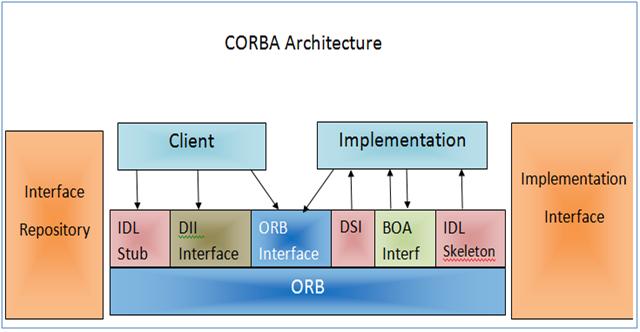CSC/ECE 517 Fall 2010/ch6 6i ak: Difference between revisions
No edit summary |
No edit summary |
||
| Line 12: | Line 12: | ||
Let us take a look at each one of these components and their functions. | Let us take a look at each one of these components and their functions. | ||
* Client | |||
* Implementation | |||
* IDL Stub & Skeleton | |||
* DII Interface | |||
* ORB Interface and ORB | |||
* DSI | |||
* BOA Interface | |||
* Interface Repository | |||
* Implementation Interface | |||
Revision as of 23:33, 16 November 2010
Introduction
Business applications have evolved gradually over time from the ages of monolithic architectures, witnessing a slow transition to the Client-server architecture and then to multitier-client server architecture and culminating with Distributed systems and it still continues to evolve.... So at any point in time, there would be different systems involving different architecture and should still be able to communicate with each other. There is also a possibility that some of the systems have a monolithic architecture, while others have an architecture of recent times. The more diversified the systems are, more is the need for a standard interface encompassing two important features a) Platform Independence b) Language Independence for an effective exchange of information between such systems. CORBA is instrumental in implementing this utopia!
In today's distributed environment, a system exposes its functionalities through objects for other systems to utilize. These objects in turn make use of services provided by other objects within the same system or across systems. CORBA (Common Object Request Broker Architecture) is an Object oriented architecture to utilize a plethora of services available from various objects that reside in different systems within same or different networks, in a manner that language and platform independent.
CORBA Architecture:

Let us take a look at each one of these components and their functions.
- Client
- Implementation
- IDL Stub & Skeleton
- DII Interface
- ORB Interface and ORB
- DSI
- BOA Interface
- Interface Repository
- Implementation Interface
CORBA's platform independence (ORM)
Previously, we mentioned that CORBA is language independent and it is the ORB(Object Request Broker) that makes CORBA language independent by performing the following functions. Below figure illustrates how message exchanges happen between CORBA objects (client and the server) via the ORB.

From the figure, we could understand the functions of ORB:
- Enable communication between objects
- Locate a remote object given a object reference
- Marshal parameters to remote method invocation
- Un-marshal parameters from remote method invocation
CORBA's language independence (IDL)
References
1.http://en.wikipedia.org/wiki/Transaction_Processing_Facility
2.orbix CORBA http://web.progress.com/en/orbix/orbix_mainframe.html 3.http://www.ibm.com/developerworks/webservices/library/ws-exploring-corba/